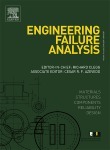Journal
Please choose volume & issue:
-
Failure analysis of a plastic modular belt in-service
Abstracts:In this study, an analysis of the possible causes of the failure in-service of a section of a plastic modular belt was conducted. The study begins with a reproduction of the service conditions in a traction gear. An analysis of the fracture surfaces revealed the existence of defects in the interior of the parts. With the aim of determining the origin of the imperfections and their influence on the failure, an exhaustive mechanical and rheological characterization of the material was carried out. The development of an FE Analysis established that the reduction of the tensile strength of the part due to internal defects was around 70%. Tests also showed that the most stressed area was the area where the most defects appeared. A simulation of the injection process showed that the defects are caused by the geometry of the part, leading to the conclusion that its failure was caused by bad dimensioning of thicknesses.
-
Damage assessment of the corrosion-resistant performances for organic coating systems after accelerated tests using analytic hierarchy process
Abstracts:It is very significant to comprehensively evaluate corrosion-resistant levels of an organic coating system after accelerated tests or outdoor exposures. In this study, the comprehensive evaluation model of the tested or exposed organic coating systems was established with Analytic Hierarchy Process (AHP) based on their eight types of the often observable and measureable failure modes, and that this model was verified by the electrochemical impedance data based on their electrochemical impedances spectroscopies (EIS). The corrosion-resistant performance levels of the tested or exposed organic coating systems were defined based on the comprehensively evaluated values. The relationship of their comprehensively evaluated values with the electrochemical impedances of the tested or exposed organic coating systems was proposed. Finally, this model was used to assess the corrosion-resistant performances of the coated aluminum alloys with three types of availably commercial organic coatings after accelerated tests. The results showed that the comprehensive evaluation model was verified to be reasonable to straightforwardly and comprehensively assess the corrosion-resistant performance levels of the tested or exposed organic coating systems after accelerated tests in a laboratory which simulate different corrosive atmospheric environments.
Hot Journals
- Risk Breakdown Matrix for Risk-Based Inspection of Transportation Infrastructure Projects
- Social Control in Outsourced Architectural and Engineering Design Consulting Projects: Behavioral Consequences and Motivational Mechanism
- 2022 Best Paper Award
- Hold-Ups and Failures in Negotiated Order: Unearthing the Nuances of Rework Causation in Construction
- Prevalence and Risk Factors for Poor Mental Health and Suicidal Ideation in the Nigerian Construction Industry
- CFRP–Cable-Stayed Bridge Hybrid with Partial Suspension and a Span Exceeding 3,000 m: Concept, Optimization, and Construction
- Impact of Wind Load Characteristics on Computed Bridge Stay-Cable Forces Used for Bridge Health Monitoring
- Weak-End and Frequency Detection of Elastically Supported Bridges by Contact Residual Response of Two-Axle Test Vehicle in a Round Trip
- Development of Performance-Based Fragility Curves of Coastal Bridges Subjected to Extreme Wave-Induced Loads
- An Analytical Model to Evaluate Short- and Long-Term Performances of Post-Tensioned Concrete Box-Girder Bridges Rehabilitated by an Ultrahigh-Performance Concrete Overlay
- Three-Dimensional Velocity Distribution in Straight Smooth Channels Modeled by Modified Log-Law
- Experimental Investigation on Flow Past Two and Three Side-by-Side Inclined Cylinders
- An Experimental Investigation of Rotor–Box Aerodynamic Interaction 1
- Modeling Gas–Liquid Flow Between Rotating and Nonrotating Annular Disks
- Entry Length Requirements for Two- and Three-Dimensional Laminar Couette–Poiseuille Flows
Advanced Materials (3,745)
- Structured Perovskite Light Absorbers for Efficient and Stable Photovoltaics
- Strategies for High‐Performance Solid‐State Triplet–Triplet‐Annihilation‐Based Photon Upconversion
- Atomic Engineering Catalyzed MnO2 Electrolysis Kinetics for a Hybrid Aqueous Battery with High Power and Energy Density
- Crystal Adaptronics: Global Performance Indices for Dynamic Crystals as Organic Thermal Actuators (Adv. Mater. 20/2020)
- Enlightening Materials with Photoswitches
Acta Astronautica (1,768)
- Mixed-integer trajectory optimization with no-fly zone constraints for a hypersonic vehicle
- Adaptive control design for active Pogo suppression of large strap-on liquid launch vehicles
- Machine learning based approach for modeling and forecasting of GPS–TEC during diverse solar phase periods
- Effect of two-dimensional micro-cavity surface on hypersonic boundary layer
- Investigation on burning behaviors of aluminum agglomerates in solid rocket motor with detailed combustion model








 User Center
User Center My Training Class
My Training Class Feedback
Feedback





